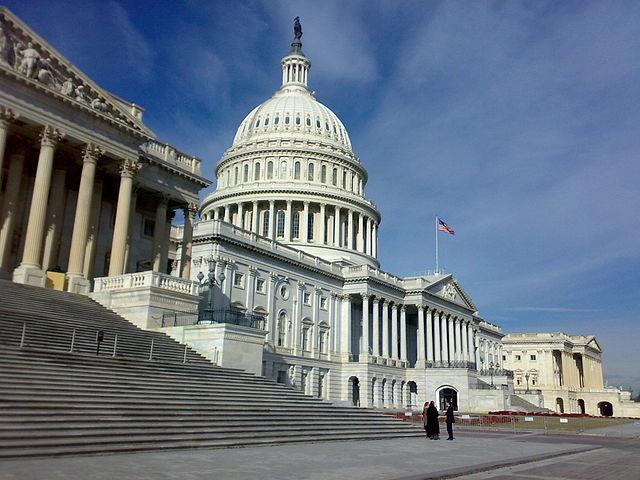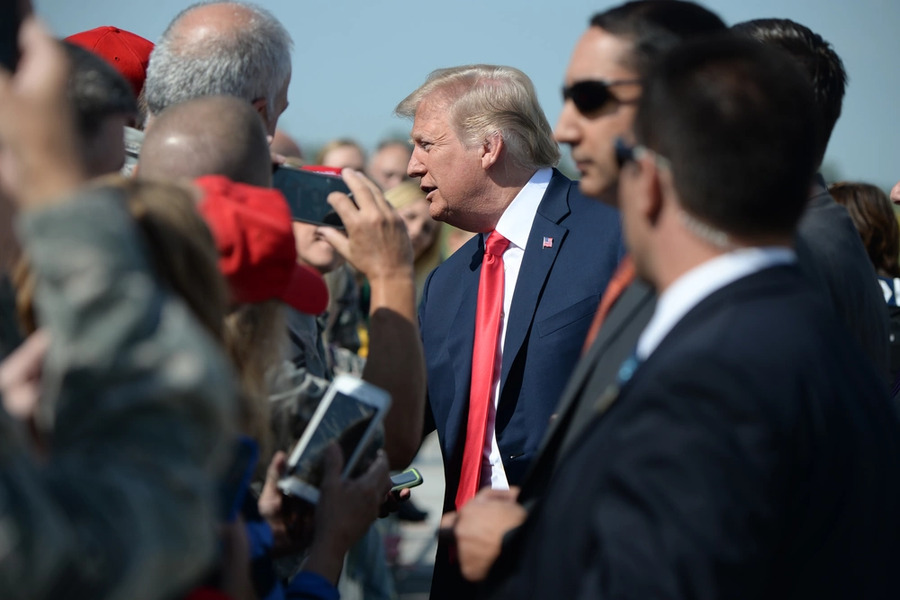Tracking Congress’s Library of Secret Law: Legislative Update for the 114th and 115th Congresses
This week, three national security committees are “marking up” drafts of their annual bills.

Published by The Lawfare Institute
in Cooperation With

This week, three national security committees are “marking up” drafts of their annual bills. Based on the early drafts (the “Chairman’s marks”), this year will likely see Congress continuing to write Public Law provisions creating secret law at an historically high tempo.
Last year on Lawfare, I summarized the legislative component of my 2015 general study of secret law as a three-branch phenomenon. My research shows that it is not, in fact, true that all the law Congress writes is public. We are now nearing the end of the fourth decade of congressional secret law, which takes the form of classified legislative documents given the force of law through references in three annual intelligence and national defense statutes.
After a refresher, this post provides a legislative update. I analyze the public record regarding Congress’s classified legislating in the now-completed 114th Congress (2015-17) and in the current 115th Congress to date. I flag a notable precedent for secret law’s contraction and recommend that Congress legislate automatic sunsets for all existing and future secret law.
- Background
As I explained in my earlier post:
By using the term “secret law” to describe what Congress is doing here, I do not mean to suggest anything nefarious. Having served in all three branches of government, including in the Intelligence Community, I have the greatest regard for the public servants who draft and implement secret law, and for the very real national security considerations that drive its creation. I mean only that there is a body of law that meets the following definition: legal authorities that require compliance that are classified or otherwise unpublished.
Congressional secret law is a practical response to a dilemma: how does Congress govern in detail secret activities via statutes that are literally Public Law?
For nearly 40 years Congress has written Public Law provisions that give legal force in part or in full to classified addenda—a collective term for classified documents that committees have given a variety of names over the years (e.g., classified annex, classified schedule, classified appendix). The statutory provisions vary in how much of the addenda they give legal force, and in how much they tell the public about what is in the classified addenda. Some provisions tell us nothing, while others have mentioned covert actions, missile programs, counter-intelligence surveillance, and other matters.
Secret law is inevitably problematic and normatively disfavored in a republic, as I explored in my general study of secret law and summarized in blog posts at Just Security. On the other hand, there are reasonable arguments for secret law. It enables the law (and lawyers) to manage in granular detail the darkest corners of the national security black box, without compromising classified information or tipping off the bad guys. Secret law is also a limited phenomenon in all three branches. In Congress, typically less than two percent of all enacted laws per session create secret law.
Note, however, that congressional production of secret law appears to be rising this decade. Vocativ created a nifty GIF using my study’s data, juxtaposing the overall decline in Congress’s legislative productivity with the sharp spike this decade in statutory provisions that create secret law. I see no evidence to suggest a diabolical direct trade-off—that Congress is consciously choosing to write secret law rather than public law. Instead, there may be a cause common to both phenomena: rising distrust and acrimony in Washington. This atmosphere makes statutes harder to pass, and may also prompt Congress, in the bills it can pass, to do all it can to keep the Executive Branch on a short leash. Another explanation might be that as Congress in recent years has written its Public Law provisions creating secret law more narrowly, it has written more of them to do the same work. These are theories; Congress has not explained the upward trajectory the data shows.
Other enduring unknowns about the classified addenda include: Has Congress been including more or fewer provisions in the classified addenda over time? Writing addenda with more or fewer pages (and how many pages)? Are their secret provisions compiled or organized in some way? Do they reference secret law in other branches, such as classified presidential orders, Justice Department opinions, or Foreign Intelligence Surveillance Court decisions? And, how long does Congress’s secret law remain in force?
- Legislative Update: Continuing Trends
My 2015 study reviewed the legislative record from the 95th through 113th Congresses (1977 to 2015). The most obvious takeaway from analysis of the now-completed 114th Congress and current 115th Congress to date is that Congress is continuing to write Public Law provisions that create secret law at an accelerated pace.
From the late 1970s through the mid-2000s, a typical two-year Congress enacted between two and four bills containing a total of four to seven statutory provisions one could reasonably read to give classified addenda legal force (with brief spikes proximate to the two Iraq wars and 9/11). Taken together, in the 112th and 113th Congresses (2011-15) covered by my earlier study, Congress matched its prior peak in number of enacted bills creating secret law (seven) and reached new heights in number of statutory provisions in those bills creating secret law (19).
In the 114th Congress, the numbers were down: Congress enacted only four bills (in three Public Laws, because two were combined into one larger omnibus) containing a total of ten provisions reasonably read to create law inside the classified addenda (the data is here).

These declines in the last Congress, however, were due mainly to Congress failing to enact the fiscal 2017 Intelligence Authorization Act (IAA) and Department of Defense Appropriations Act (DODAA) before the 114th Congress ended. When those two annual Acts and their four secret law-creating provisions—enacted in an omnibus on May 5, 2017, during the 115th Congress—are factored in, it is clear that Congress’s historically accelerated pace continues.
The spike in Public Law provisions creating secret law happened during a time of spiraling acrimony and divided government. It will be interesting to see if this trend now continues under a unified Republican government—albeit one in which relations between Congress and the Trump Administration have been strained. It is early, but so far the answer appears to be yes: the two “Chairman’s marks” released so far this week both include recurring annual provisions giving classified budget tables legal force.
In a second continuing trend, the nation’s legislature in the 114th and so far 115th Congresses is employing a variety of different provisions to give legal force to the classified addenda and explain Congress’s intent. Each of three annual bills with addenda—the IAAs, the DODAAs, and the National Defense Authorization Acts (NDAAs)—and nearly half of their secret law-creating statutory provisions have in recent years given force of law to some or all of their classified budget tables en bloc via recurring annual provisions. (Although note that they differ across the three annual Acts—a topic for a future post). Other ad hoc statutory provisions make individual classified directives into law. Meanwhile, explanatory language in unclassified reports emphasizes that the classified addenda provide thorough discussion of congressional and committee intent and direction.
A third ongoing trend evident in the 114th and 115th Congresses is use of the classified addenda to regulate a wide array of intelligence and military activities—and to do more than hand agencies cash via the “black budget.”
In the 114th Congress, for example, the House Intelligence Committee observed that its 2016 IAA
funds all U.S. intelligence activities, spanning 16 separate agencies. It provides authorization for critical national security functions, including: fighting terrorism and countering the proliferation of weapons of mass destruction; funding efforts to recover from unauthorized disclosures of intelligence capabilities; sustaining activities in Afghanistan and Iraq; investing in the resiliency of our national security space architecture; providing policy direction on sensitive intelligence operations; promoting intelligence integration through investment in Intelligence Community-wide information technology enterprises; augmenting military-related intelligence, surveillance, and reconnaissance capabilities; and funding initiatives to prevent cyber attacks and detect insider threats….As most of the intelligence budget involves highly classified programs, the bulk of this Committee’s recommendations each year are found in the classified annexes to the bill.
Meanwhile, the explanatory statement (report) associated with the final version of the 2016 DODAA stated broadly that
Adjustments to classified programs are addressed in a separate, detailed, and comprehensive classified annex. The Intelligence Community, the Department of Defense, and other organizations are expected to fully comply with the recommendations and directions in the classified annex….
A sampling of statutory provisions giving legal force to particular parts of the classified addenda indicate how useful the addenda have been to Congress in recent years as regulatory instruments. In a section inferentially about U.S. proxy forces, the 2016 DODAA (Sec. 8121) required notification of Congress as directed in a classified addendum before spending money on “foreign forces, irregular forces, groups, or individuals.” The 2016 NDAA had a provision on a thorny issue in NATO-Russian relations: the NDAA (in Sec. 1677) required the Pentagon’s compliance with classified congressional directives about discussions with NATO and force planning regarding air and missile defenses in Eastern Europe. The next year, unclassified budget tables for the 2017 NDAA showed money moving into and out of classified budget tables for a Missile Defense Agency “special program” and for an apparent Army R&D effort called TRACTOR HIKE. (I have no idea what TRACTOR HIKE is, but I assure you that with its companions, TRACTOR EGGS, TRACTOR ROSE, TRACTOR NAIL, and TRACTOR CAGE, it will become something interesting in the next Ohio State National Security Simulation in November.)
In short, the signs are clear that Congress continues to be busy in using the classified addenda to govern and regulate the national security apparatus.
- Legislative Update—and Legislative Recommendation—on Sunsetting Secret Law
In the 114th Congress, the nation’s legislature not only added to its library of classified legislation but also trimmed it back. Congress should build on this precedent and legislate automatic sunsets for all secret law, current and future.
In the NDAA for 2014 (Sec. 1041), Congress wrote a standing provision, 10 U.S.C. § 130f, requiring the Secretary of Defense to report to Congress on “sensitive military operations”—off-battlefield kill or capture operations. Working “10/50” ground—the intersection of military and intelligence operations—Congress created a narrower Title 10 sibling of the Title 50 covert action statute, 50 U.S.C. § 3093. The original new provision included a reference to a classified addendum, which appeared to concern reports by the Secretary of Defense on military support for covert actions and other Title 50 activities usually conducted by intelligence agencies:
(a) In General. – The Secretary of Defense shall promptly submit to the congressional defense committees notice in writing of any sensitive military operation conducted under this title following such operation. Department of Defense support to operations conducted under the National Security Act of 1947 (50 U.S.C. 3001 et seq.) is addressed in the classified annex prepared to accompany the National Defense Authorization Act for Fiscal Year 2014.*
As Bobby Chesney has explained, the 2017 NDAA revised and simplified the provision, found in current form at 10 U.S.C. § 130f. In the process, Congress deleted the reference to the classified addendum.
Given the general norm in our republic against secret law, Congress deserves praise for removing an unnecessary reference in the U.S. Code.
Congress should now take the additional step of passing a Public Law requiring automatic sunsets for all classified addenda, and for any statutory references giving the addenda legal force. These sunsets ideally would be part of a comprehensive Secret Law Management Act that would sunset all current and future secret law—in all branches—within a relatively short timeframe, such as two or four years (the length of one Congress or one presidential term).
Obviously, sunsets will be attractive to secret law abolitionists who believe any secret law is an abomination. Automatic sunsets also make good sense if, as I have discussed, the republic instead chooses to tolerate some amount of secret law and govern it with rules of the road.
A standing sunset in Public Law for all secret law would underscore that public law is supreme and secret law is disfavored. It would prompt regular review. It would force today’s public officials to act affirmatively to extend secret law they inherit and want to continue. A sunset would also combat deeply secret law, in which not just the law’s details but its entire existence is unknown. Each of these advantages reflect fundamental principles for governing secret law—the Public Law Supremacy Rule, the Anti-Inertia / Public Official Responsibility Principle, and the Shallow Secrecy Principle—that I posited in my 2015 secret law study.
Sunsets would not compromise classified sources, methods, programs, or information. Nor would additional transparency regarding the classified addenda (number of pages, and number, organization, and duration of provisions). Instead, these steps would help the public to track Congress’s library of secret law, while controlling the scope of and increasing accountability for secret law in all three branches of government.
***
* When I conducted my 2015 study (see p. 364), I debated whether to score Sec. 1041 of the 2014 NDAA as creating secret law. There are good arguments both ways. In keeping with my study’s conservative methodology, I ultimately chose not to score it because the textual term “addressed,” on its face, did not clearly suggest that compliance with the classified addendum’s provisions was legally required. Still, it is a Public Law reference to a secret legal document, other parts of which were given legal force by other provisions in the 2014 NDAA. At the least the classified provision would be important legislative history in interpreting Sec. 1041. It is reasonable, therefore, to include Sec. 1041 in discussions of secret law—and to note that Congress has done the right thing in removing an unnecessary reference.




-final.png?sfvrsn=b70826ae_3)
